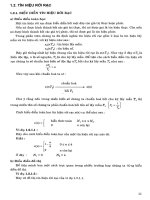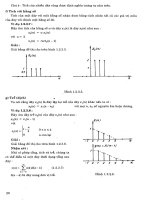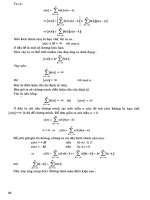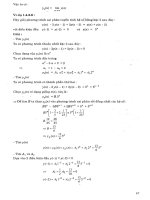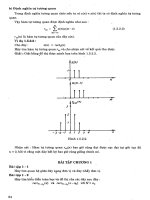XỬ LÝ TÍN HIỆU SỐ Dsp chapter5 student 19072015
Bạn đang xem bản rút gọn của tài liệu. Xem và tải ngay bản đầy đủ của tài liệu tại đây (749.4 KB, 35 trang )
Chapter 5
z-Transform
Nguyen Thanh Tuan, Click
M.Eng.
to edit Master subtitle style
Department of Telecommunications (113B3)
Ho Chi Minh City University of Technology
Email:
The z-transform is a tool for analysis, design and implementation of
discrete-time signals and LTI systems.
Convolution in time-domain multiplication in the z-domain
Digital Signal Processing
2
z-Transform
Content
1. z-transform
2. Properties of the z-transform
3. Causality and Stability
4. Inverse z-transform
Digital Signal Processing
3
z-Transform
1. The z-transform
The z-transform of a discrete-time signal x(n) is defined as the power
series:
X ( z)
n
2
1
2
x
(
n
)
z
x
(
2
)
z
x
(
1
)
z
x
(
0
)
x
(
1
)
z
x
(
2
)
z
n
The region of convergence (ROC) of X(z) is the set of all values of
z for which X(z) attains a finite value.
ROC {z C | X ( z )
x ( n) z
n
}
n
The z-transform of impulse response h(n) is called the transform
function of the filter:
H ( z)
n
h
(
n
)
z
n
Digital Signal Processing
4
z-Transform
Example 1
Determine the z-transform of the following finite-duration signals
a) x1(n)=[1, 2, 5, 7, 0, 1]
b) x2(n)=x1(n-2)
c) x3(n)=x1(n+2)
d) x4(n)=(n)
e) x5(n)=(n-k), k>0
f) x6(n)=(n+k), k>0
Digital Signal Processing
5
z-Transform
Example 2
Determine the z-transform of the signal
a) x(n)=(0.5)nu(n)
b) x(n)=-(0.5)nu(-n-1)
Digital Signal Processing
6
z-Transform
z-transform and ROC
It is possible for two different signal x(n) to have the same ztransform. Such signals can be distinguished in the z-domain by their
region of convergence.
z-transforms:
and their ROCs:
ROC of a causal signal is the
exterior of a circle.
Digital Signal Processing
7
ROC of an anticausal signal
is the interior of a circle.
z-Transform
Example 3
Determine the z-transform of the signal
x(n) a nu(n) b nu(n 1)
The ROC of two-sided signal is a ring (annular region).
Digital Signal Processing
8
z-Transform
2. Properties of the z-transform
Linearity:
if
and
z
x1 (n)
X 1 ( z ) with ROC1
z
x2 (n)
X 2 ( z ) with ROC2
then
z
x(n) x1 (n) x2 (n)
X ( z) X1 ( z) X 2 ( z) with ROC ROC1 ROC2
Example: Determine the z-transform and ROC of the signals
a) x(n)=[3(2)n-4(3)n]u(n)
b) x(n)=cos(w0 n)u(n)
c) x(n)=sin(w0 n)u(n)
Digital Signal Processing
9
z-Transform
2. Properties of the z-transform
Time shifting:
if
then
z
x(n)
X ( z)
z
x(n D)
z D X ( z)
The ROC of z D X (z ) is the same as that of X(z) except for z=0 if
D>0 and z= if D<0.
Example: Determine the z-transform of the signal x(n)=2nu(n-1).
Scaling in the z-domain:
z
x(n)
X ( z ) ROC : r1 | z | r2
if
then a n x(n)
z
X (a 1 z ) ROC : | a | r1 | z || a | r2
for any constant a, real or complex
Example: Determine the z-transform of the signal x(n)=ancos(w0n)u(n).
Digital Signal Processing
10
z-Transform
2. Properties of the z-transform
Time reversal:
z
x(n)
X ( z ) ROC : r1 | z | r2
if
1
1
z
then
x ( n)
X ( z 1 ) ROC : | z |
r2
r1
Example: Determine the z-transform of the signal x(n)=u(-n).
Convolution of two sequence:
z
z
x2 (n)
X 2 ( z)
X 1 ( z ) and
if x1 (n)
z
then x(n) x1 (n) x2 (n)
X ( z) X1 ( z) X 2 ( z)
the ROC is, at least, the intersection of that for X1(z) and X2(z).
Example: Compute the convolution of x=[1 1 3 0 2 1] and h=[1, -2, 1] ?
Digital Signal Processing
11
z-Transform
2. Properties of the z-transform
Differentiation in the z-domain
z
x(n)
X ( z)
if
dX ( z )
z
then
nx(n)
z
dz
the ROCs of both are the same.
Example: Determine the z-transform of the signal x(n)=nanu(n).
Digital Signal Processing
12
z-Transform
3. Causality and stability
A causal signal of the form
x(n) A1 p1nu(n) A2 p2nu(n)
will have z-transform
A1
A2
X ( z)
ROC| z | max | pi |
1
1
i
1 p1 z
1 p2 z
the ROC of causal signals are outside of the circle.
A anticausal signal of the form
x(n) A1 p1nu(n 1) A2 p2nu(n 1)
X ( z)
A1
A2
ROC| z | min | pi |
1
1
i
1 p1 z
1 p2 z
the ROC of causal signals are inside of the circle.
Digital Signal Processing
13
z-Transform
3. Causality and stability
Mixed signals have ROCs that are the annular region between two
circles.
It can be shown that a necessary and sufficient condition for the
stability of a signal x(n) is that its ROC contains the unit circle.
Digital Signal Processing
14
z-Transform
4. Inverse z-transform
transform
x(n) z
X ( z ), ROC
transform
X ( z), ROC inverse
z-
x(n)
z
x(n)
X ( z ), ROC
In inverting a z-transform, it is convenient to break it into its partial
fraction (PF) expression form, i.e., into a sum of individual pole
terms whose inverse z transforms are known.
1
Note that with X ( z )
-1 we have
1 - az
a nu (n) if ROC | z || a | (causal signals)
x ( n) n
a u (n 1) if ROC | z || a | (anticausal signals)
Digital Signal Processing
15
z-Transform
Partial fraction expression method
In general, the z-transform is of the form
N ( z ) b0 b1 z 1 bN z N
X ( z)
D( z )
1 a0 z 1 aM z M
The poles are defined as the solutions of D(z)=0. There will be M
poles, say at p1, p2,…,pM . Then, we can write
D( z ) (1 p1 z 1 )(1 p2 z 1 )(1 pM z 1 )
If N < M and all M poles are single poles.
where
Digital Signal Processing
16
z-Transform
Example 4d
Compute all possible inverse z-transform of
Solution:
- Find the poles:
1-0.25z-2 =0 p1=0.5, p2=-0.5
- We have N=1 and M=2, i.e., N < M. Thus, we can write
where
Digital Signal Processing
17
z-Transform
Example 5od
Digital Signal Processing
18
z-Transform
Partial fraction expression method
If N=M
Where
and
for i=1,…,M
If N> M
Digital Signal Processing
19
z-Transform
Example 6
Compute all possible inverse z-transform of
Solution:
- Find the poles:
1-0.25z-2 =0 p1=0.5, p2=-0.5
- We have N=2 and M=2, i.e., N = M. Thus, we can write
where
Digital Signal Processing
20
z-Transform



